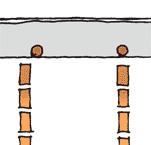Energy
Designing homes to conserve energy and use it efficiently, from sources that cause least environmental harm.
Radiant heaters
In radiant heating, surfaces (including people’s skin and clothing) are heated by infrared rays of heat from the heater. The air in between is not heated.
Find out about:
- types of residential radiant heaters
- characteristics of radiant heaters
- use of radiant heaters.
Types of residential radiant heaters
Typical residential radiant heaters include:
- electric radiant panel or element heaters (including infrared panel heaters), wall or ceiling-mounted
- bathroom ceiling-mounted electric heat lamps (with exhaust air duct)
- gas-fired infrared (outdoor) heaters
- gas-fired radiant tube heaters
- gas fires (visible flame) (a number of gas fires provide both radiant and convection heating)
- electric tubular heaters.
The sun and warmed outdoor surfaces also provide radiant heat.
Note: BRANZ does not recommend the use of unflued radiant gas heaters because they emit water vapour and other gases into indoor spaces.

- Radiant heater
Radiant heaters heat surfaces, objects and occupants with infrared radiation. They do not heat the air within the room directly.
Characteristics of radiant heaters
Radiant heating provides immediate heat:
- Someone directly in front of the heater will feel immediately warmer when it is turned on and immediately cooler when it is turned off.
- Only surfaces in a direct line of sight to the heater are heated.
- Though air isn’t directly warmed, it will warm up through contact with surfaces that have been heated.
- Heating intensity increases as the surface gets closer to the heater.
Uses of radiant heaters
Radiant heaters can be useful for heating spaces with:
- short-term room occupancy (for example, using a bathroom, making a drink in a kitchen)
- a need for immediate warmth
- large size (for example, long rooms, rooms with high ceilings) to directly provide heat to occupants
- high or fast air flow from outside or other cooler spaces (for example, garage, basement, deck)
- high transmission heat loss through walls or the floor or ceiling (for example, a conservatory in winter)
- high humidity (for example, bathrooms) with surfaces that temporarily need to be clear of condensation (for example, mirrors)
- occupants who are very active and mobile while in the room (for example, people doing aerobics or working in a garage workshop)
- rooms with thermal mass (as the heater warms the mass).
A radiant heater will be less effective and less efficient compared to a convection heater if:
- the radiant heat cannot freely radiate into the room (for example, because the heater is behind furniture) and/or directly on to the room occupant
- the heater is distant from the occupant
- it is installed directly facing a window – heat energy will be lost through the glass
- the room is already very warm and near to desired air temperature
- the room has longer-term problems with condensation and moisture damage
- tight thermostatic control is required
- safety from touch is an issue.
More information
- www.smarterhomes.org.nz – heating
Updated: 22 January 2019

